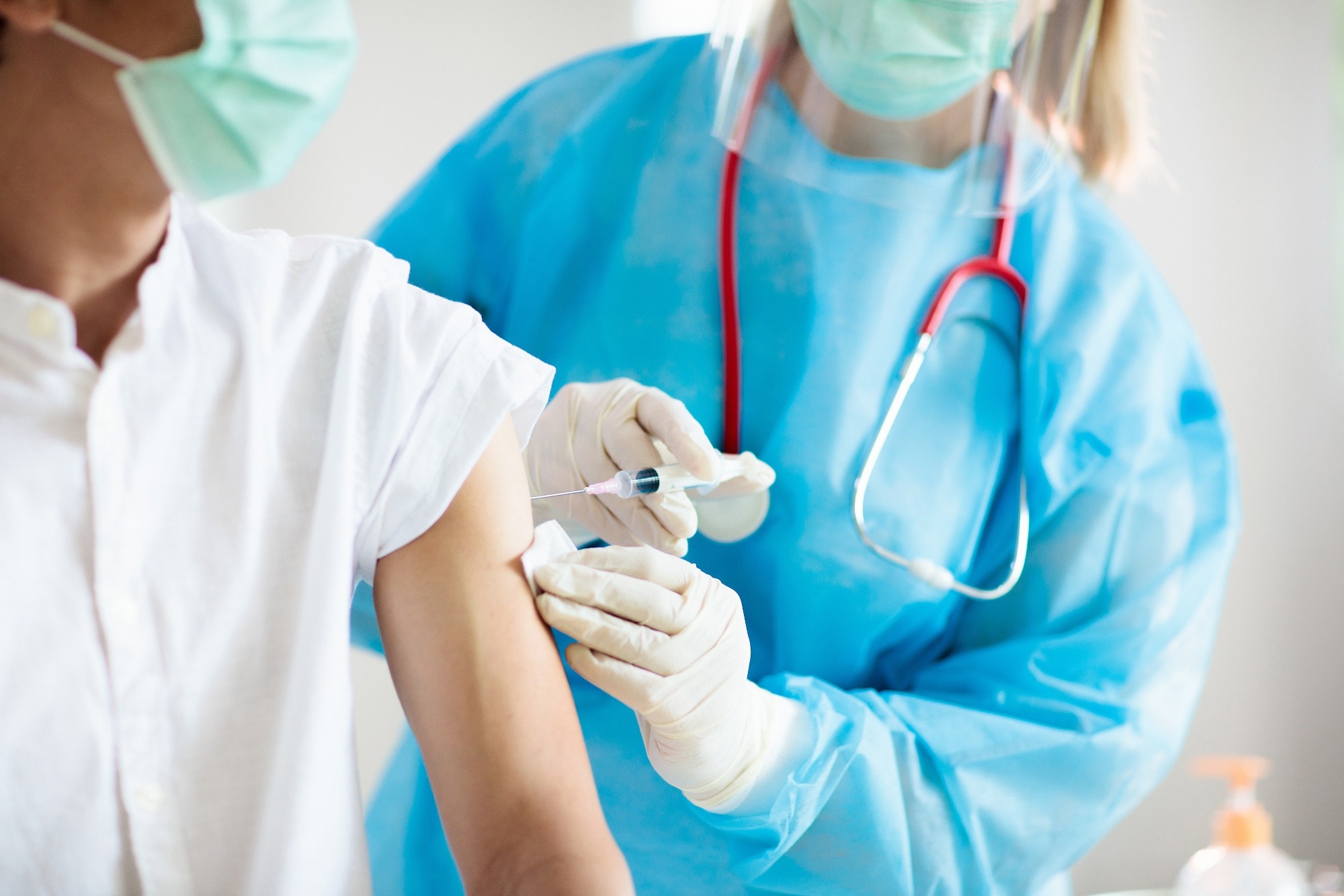In a recent study published in JAMA Network Open, researchers evaluated the efficacy, immunogenicity, and safety of Novavax’s NVX-CoV2373 vaccine in preventing coronavirus disease 2019 (COVID-19) among 12-to 17-year-old adolescents.
 Safety, Immunogenicity, and Efficacy of the NVX-CoV2373 COVID-19 Vaccine in Adolescents: A Randomized Clinical Trial. Image Credit: FamVeld / Shutterstock
Safety, Immunogenicity, and Efficacy of the NVX-CoV2373 COVID-19 Vaccine in Adolescents: A Randomized Clinical Trial. Image Credit: FamVeld / Shutterstock
Background
COVID-19 has caused unprecedented morbidity and mortality among adults as well as children. Mitigation of severe acute respiratory syndrome coronavirus 2 (SARS-CoV-2) infections requires extending vaccination coverage to individuals of all age groups to reduce the global health burden of COVID-19, particularly the mental health burden among adolescents.
The PREVENT-19 phase 3 trial findings demonstrated that the recombinant SARS-CoV-2 spike (S) protein-encoding and Matrix-M-adjuvanted NVX-CoV2373 vaccine was effective and safe among adults in preventing symptomatic SARS-CoV-2 infections. Following the results, the trial was expanded to include vaccine assessments among adolescents.
About the study
In the present randomized controlled trial (RCT), researchers investigated whether NVX-CoV2373 was safe, immunogenic, and effective among adolescents.
The ongoing PREVENT-19 placebo-controlled, observer-blinded trial was conducted across 73 centers in the United States (US). Adolescents were recruited between 26 April and 5 June 2021 and included blinded-type crossover between the study groups after two months of follow-up evaluations concerning vaccine safety to provide active vaccines to all individuals.
A total of 57 adolescents with immunosuppressive conditions or prior COVID-19 history were excluded from the analysis. Therefore, out of 2,304 adolescents screened initially, 2,247 were 2:1 randomized to receive either two 0.50 mL intramuscular (IM.) NVX-CoV2373 vaccine injections (comprising 5.0 μg and 50.0 μg of SARS-CoV-2 spike protein and adjuvant, respectively) or placebo (normal saline, NS), 3.0 weeks apart.
The primary study outcomes were serologic non-inferiority in neutralizing antibody (nAb) responses among adolescents compared to those among the young adult cohort of PREVENT-19, including individuals aged between 18 and 25 years; vaccine efficacy against SARS-CoV-2 infection, and safety and reactogenicity evaluation.
Data of solicited-type adverse events (AEs) at the local and systemic levels were obtained via electronic diaries for one week following every injection. Unsolicited AEs were reported following the initial dose up to 4.0 weeks post-second dose. SARS-CoV-2 nAb titers were measured in serum samples obtained at baseline (day 0) and 35 days later using microneutralization assays.
In addition, serological human angiotensin-converting enzyme-2 (hACE2)-binding inhibition antibody titers and anti-S protein immunoglobulin G (IgG) titers were determined using enzyme-linked immunosorbent assays (ELISA). Further, a post hoc analysis was performed by measuring humoral responses against SARS-CoV-2 variants of concern (VOCs), such as the Alpha VOC, Beta VOC, Gamma VOC, Delta VOC, and Omicron VOC, and variants of interest (VOIs) such as the Mu VOI. Prior SARS-CoV-2 exposure was determined based on serological anti-nucleoprotein antibody presence and/or reverse transcription polymerase chain reaction (RT-PCR)-positive results for SARS-CoV-2, analyzed using nasal swab samples that were obtained from the participants at study initiation.
NVX-CoV2373 vaccine efficacy in preventing RT-PCR-verified symptomatic COVID-19 [based on the United States Food and Drug Administration (FDA) guidelines] with onset after ≥1.0 weeks of the second vaccination was assessed for the per-protocol evaluation of vaccine efficacy. The team performed whole-genome sequencing (WGS) on samples testing SARS-CoV-2-positive by RT-PCR with adequate SARS-CoV-2 ribonucleic acid (RNA) load.
Results
Among 2,232 adolescents, 1487 and 745 adolescents belonged to the NVX-CoV2373 vaccination group and placebo group, respectively. The mean participant age was 14 years; 53% (n=1,172) were male, 74% (n=1,660) were white, and 16% (n=359) had prior COVID-19 history. Following COVID-19 vaccination, a value of 1.5 was observed by dividing the nAb geometric mean titers (GMTs) among adolescents by the titers among young adults.
Within 64 days (median) of the follow-up period, 20 cases of mild COVID-19 were reported, including six cases in the NVX-CoV2373 vaccine recipient group and 14 cases in the placebo group. The incidence rates (number of COVID-19 cases every 100 individual years) among NVX-CoV2373 vaccinees and placebo recipients were 2.9 and 14, respectively, yielding a 79.50% efficacy for NVX-CoV2373.
WGS identified only the SARS-CoV-2 Delta VOC among 11 participants, with vaccine efficacy against the Delta VOC of 82%. The nAb GMTs and humoral responses were considerably greater among the vaccinees compared to placebo recipients. On day 35.0, robust IgG titers against spike proteins of the wild-type strain and all variants tested, including Omicron BA.1, BA.2, and BA.5 sub-VOCs.
The hACE2 receptor-binding inhibition Ab titers were largely similar to the anti-S IgG titers, although lower for the Omicron sub-VOCs. Transient and mild-moderate reactogenicity was observed, with an increase in frequency following the second NVX-CoV2373 vaccination. Serious AEs were rarely observed, and none of the AEs led to the discontinuation of the study.
The most commonly observed solicited local AEs were pain and tenderness at the site of injection for ≤2.0 days, and the most frequently documented solicited systemic AEs were headache, fatigue, myalgia, and malaise. The frequencies of unsolicited AEs were comparable in the two groups.
To conclude, based on the study findings, NVX-CoV2373 vaccination was immunogenic, efficacious, and safe to prevent SARS-CoV-2 infections, including Delta VOC infections, among adolescents. The vaccine-induced SARS-CoV-2 nAb titers were comparable among adolescents and young adults.
- Áñez G, Dunkle LM, Gay CL, et al. Safety, Immunogenicity, and Efficacy of the NVX-CoV2373 COVID-19 Vaccine in Adolescents: A Randomized Clinical Trial. JAMA Netw Open. 2023;6(4):e239135. DOI: 10.1001/jamanetworkopen.2023.9135, https://jamanetwork.com/journals/jamanetworkopen/fullarticle/2804216
Posted in: Child Health News | Medical Research News | Disease/Infection News | Pharmaceutical News
Tags: Adolescents, Angiotensin, Antibody, Children, Clinical Trial, Coronavirus, Coronavirus Disease COVID-19, Efficacy, ELISA, Enzyme, Fatigue, Food, Frequency, Genome, Global Health, Headache, Immunoglobulin, Mental Health, Mortality, Omicron, Pain, Placebo, Polymerase, Polymerase Chain Reaction, Protein, Receptor, Respiratory, Ribonucleic Acid, RNA, SARS, SARS-CoV-2, Severe Acute Respiratory, Severe Acute Respiratory Syndrome, Spike Protein, Syndrome, Transcription, Vaccine

Written by
Pooja Toshniwal Paharia
Dr. based clinical-radiological diagnosis and management of oral lesions and conditions and associated maxillofacial disorders.
Source: Read Full Article